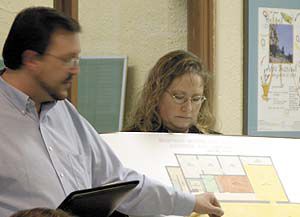| P.J. Jensen and SueAnn Martell explain the floor plan of a proposed museum expansion in Helper. Having been delayed since 2005, the project will soon into the final design process. Planners lack more than $125,000 to build the first phase, estimated to cost close to $875,000. |
Councilmembers in Helper approved a request from the Western Mining and Railroad Museum to request bids for design work for a planned museum expansion.
Delays have set back construction nearly two years.
Original bids for the project came in higher than expected. As a result, planners have suggested building the expansion in phases.
The planned expansion includes the construction of three levels north of the existing museum structure.
Because the mining and railroad museum is housed in a historic building, new construction must be smaller than the original structure.
P.J. Jensen, chairperson of the museum building committee, told the Helper mayor and councilmembers that the expansion was designed as large as possible to fit within the restrictions for historic buildings.
In October 2005, Jensen and museum director SueAnn Martell presented a plan to the city council to build the entire shell of the building, but not finish all of the interior.
After further review by the museum building committee, Jensen explained, a three phase plan has emerged.
Plans for phase one include the construction of an elevator rising from the basement to the existing third story of the building.
The basement will be expanded in the first phase for additional storage space and an archival facility.
Also in the initial building phase, the first floor will be expanded to meet the museum’s most pressing needs.
“With this new direction, most of the major needs of the museum will be met: a new elevator, new emergency exit stairway, handicapped accessible restrooms, secure storage for state archive materials, secure storage for existing museum artifacts, an expanded lobby/gift shop and an expanded office and display preparation areas,” wrote Jensen in a memo distributed to city officials.
The elevator will increase accessibility for the entire museum.
Expanded bathrooms will be able to handle more people and better meet guidelines set by the Americans with Disabilities Act.
The second story, however, is not planned to by built until phase two.
Helper museum funding sources |
|
| U.S. House of Representatives appropriation* | $250,000 |
| Utah Permanent Community Impact Fund (CIB) grant | $241,000 |
| Utah Department of Transportation mitigation funds | $118,000 |
| National Scenic Byways grant* $100,000 | |
| Carbon County Restaurant Tax grant | $70,000 |
| Utah Division of State History grant | $3,000 |
| Private donations $1,500 | |
| Union Pacific donation | $1,000 |
| Total museum funding | $784,500 |
| *The city is still awaiting release of federal funding. | |
Jensen explained that breaking different levels into separate construction phases is somewhat common and does not add significantly to the price of the building.
The floor of the second story, which exceeds the weight capacity requirements for a roof, will serve as the roof of the addition.
Because the second story floor must be built flat, insulation will be added on top of the floor to provide the necessary slope for drainage and roofing materials will be added over the insulation.
Once additional funding becomes available, the roof and insulation can be removed and the second story can be built on top of the completed first story.
Jensen explained that, by completing the first story and then building the second story, the first floor and most of the archival facility will be available sooner, which means patrons will be able to use the new facility sooner.
If the city had continued with plans to build the shell of the whole building, few areas would be completed as quickly and empty, unfinished sections of the museum could distract patrons.
By expanding the current offering, planners hope to increase museum patronage by as much as 40 percent.
Funding for the museum expansion has come from a variety of sources. Jensen pointed out that all of the funding sources are grants or congressional appropriations. That means the museum expansion project will be completed with no cost passed on to local residents.
In 2005, the city received $118,000 from the Utah Department of Transportation as mitigation funding related to the Helper interchange and the need to destroy the historic Bruno farm.
The Utah Permanent Com-munity Impact Fund Board awarded the city a $241,000 grant and, with United States Rep. Jim Matheson’s assistance, Helper received $250,000 in federal appropriations.
Another $100,000 in federal appropriations was awarded through the national scenic byways program run by the U.S. Department of Transportation. Last month, Carbon commissioners approved a recommendation from the restaurant tax board to award $70,000 in county monies to the museum.
Smaller donations have included $3,000 from the Utah Division of History, a $1,000 donation from Union Pacific and $1,500 in private donations.
Nearly $40,000 has been spent on design costs, engineering services and a new boiler for the building.
Current estimates set the cost for phase one close to $875,000 – more than $125,000 beyond what has been raised.
Jensen and Martell requested that the city council allow the project to go to bid for final design work while they continue to raise the remaining funds.
The council agreed to advertise for design bids.
Jensen said much of the design work has been done already. Designers will need to modify existing plans for the three phase approach.
Additionally, a structural engineer will need to approve the designs.
The city plans to continue using the services of electrical, plumbing and mechanical engineers who have provided services in the design phase.

